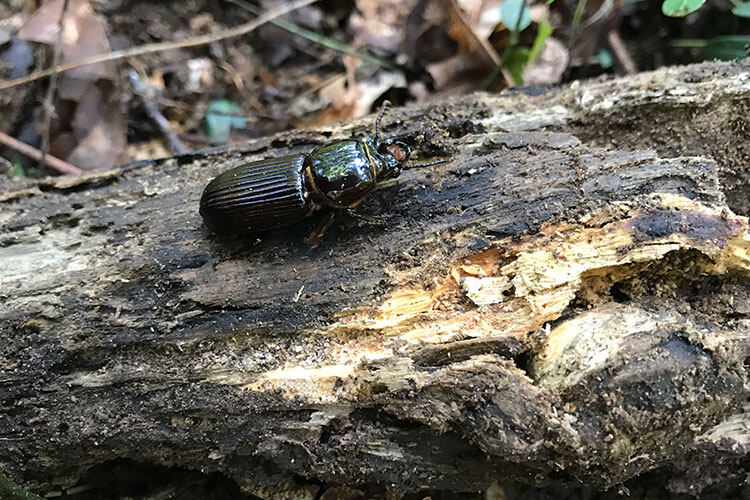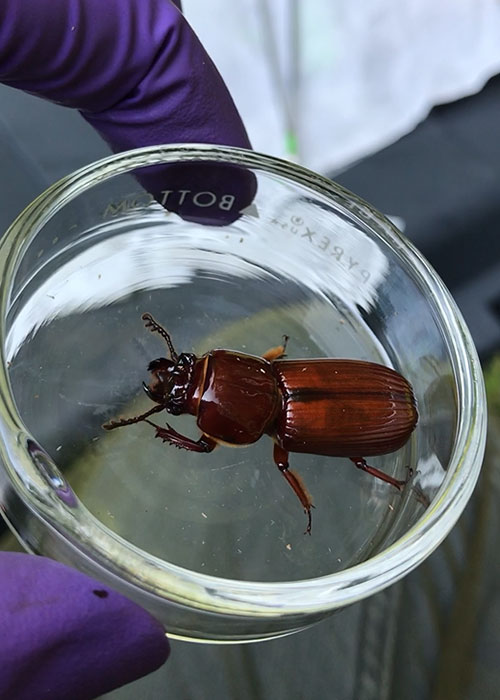

The lifestyle of the horned passalus beetle, commonly known as the bessbug or betsy beetle, might seem downright disgusting to the average human: Not only does this shiny black beetle eat its own poop, known as frass, but it uses its feces to line the walls of its living space and to help build protective chambers around its developing young.
Gross as it may seem, a new study suggests that this beetle’s frass habits are actually part of a clever strategy for protecting the insect’s health — and could help inform human medicine, too.
Researchers at the University of California, Berkeley, have discovered that the frass of the horned passalus beetle is teeming with antibiotic and antifungal chemicals similar to the ones that humans use to ward off bacterial and fungal infections. These compounds are produced by a host of beneficial bacteria called actinomycetes that live in the beetle’s frass and that appear to be passed from beetle to beetle, and from colony to colony, via the process of coprophagy — the technical term for eating poop.
Understanding the symbiotic relationship between bessbug beetles, actinomycetes and their antimicrobial compounds could help speed the search for new antibiotic drugs, and help doctors create better strategies for preventing the rise of antibiotic-resistant infections, the researchers said.


Juvenile bessbug beetles have a brownish red color soon after pupating, and then darken to a shiny black as they age. (UC Berkeley photo by Rita de Cassia Pessotti)
“Most of the antibiotics and antifungals that humans take are actually made by microbes, and we’re really interested in how microbes are using these molecules in the environment,” said study senior author Matthew Traxler, an assistant professor of plant and microbial biology at UC Berkeley. “When scientists discover a new antibiotic and bring it into the clinic, it often only takes a few years before the pathogen population starts to develop antibiotic resistance. But these microbes have been using the same molecules for millions of years, and that tells us that the way the microbes are using them is different from how we use them.”
With the discovery, bessbug beetles join a handful of other insects, including leaf-cutter ants, southern pine beetles and beewolves, or bee-killer wasps, that benefit from symbiotic relationships with actinomycete bacteria. Leaf-cutter ants and beewolves have even evolved special structures in their bodies — in their thoraxes and antennae, respectively — to carry these microbes.
No special structures for harboring bacteria have been identified on the bessbug beetle, but that may be the beetle’s advantage. While the ants and wasps are each known to associate with only one specific species of actinomycete bacteria, the researchers identified more than 30 actinomycete species associated with bessbug beetle “galleries,” the hollowed-out tunnels inside dead logs where they live. The greater diversity of actinomycetes in bessbug beetle frass appears to contribute to a greater diversity of protective antibiotics and antifungals in their galleries.
“We collected samples from galleries all over the southern and eastern U.S., and for almost all of them, we were able to detect some form of antibiotic. This was really surprising, because these compounds are usually very difficult to detect in the environment,” said study lead author Rita de Cassia Pessotti, who completed the research as a postdoctoral researcher at UC Berkeley. “We think that we are seeing larger diversity of molecules because there’s a more diverse set of bacteria as well.”
For more information or career opportunities, please contact University of California.






































